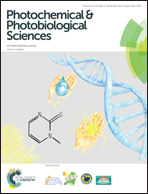Applications of a new type of poly(methyl methacrylate)/TiO2 nanocomposite as an antibacterial agent and a reducing photocatalyst†
Abstract
A new type of poly(methyl methacrylate) (PMMA)/TiO2 nanocomposite film sensitized by ionic liquids with a low dosage of TiO2 nanoparticles was prepared based on a microemulsion method. The photocatalytic activity, via the photoreduction of 4-nitrophenole (4-NP) to 4-aminophenole (4-AP) by NaBH4, and the photocatalytic-based antibacterial activity, for the destruction of Escherichia coli and Staphylococcus aureus, of the prepared nanocomposite film were investigated. The conditions for the maximum efficiency in the presence of visible light irradiation have been evaluated. The rate constant of the photoreduction of 4-NP to 4-AP was calculated and the maximum rate constant was found with the 0.01 wt% of TiO2 dosage in the photocatalyst and a solution pH of 7.5. The photocatalytic antibacterial maximum activity against Gram-negative bacteria was also obtained for the 0.01 wt% of TiO2 concentration of the photocatalyst. A notable result of this work is that PMMA/TiO2 nanocomposite films show efficient photocatalytic activity at very low loadings of TiO2, in contrast to other previous reports.


 Please wait while we load your content...
Please wait while we load your content...